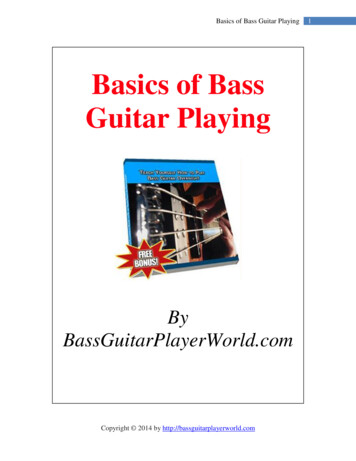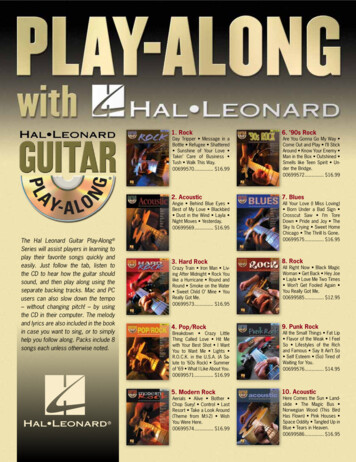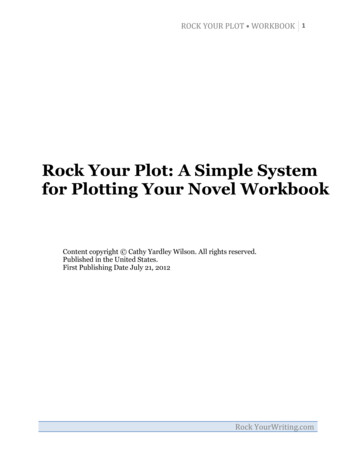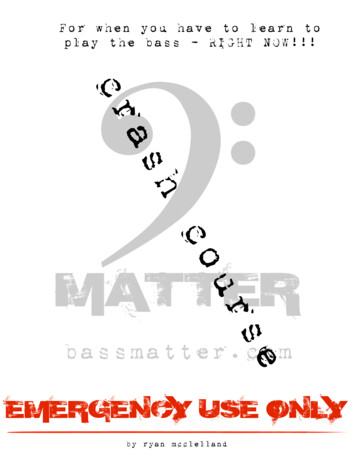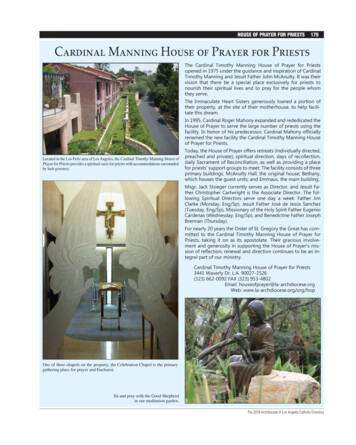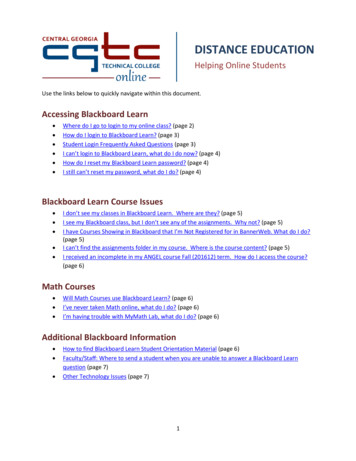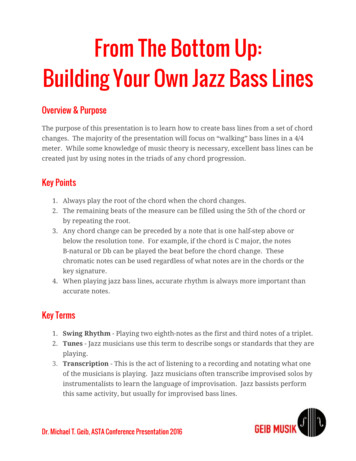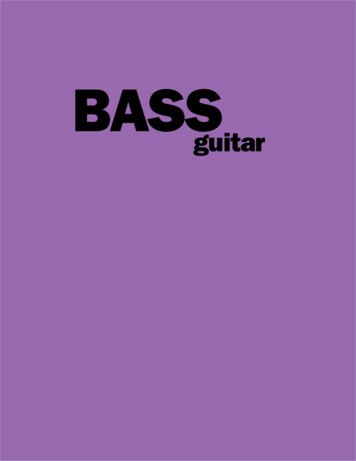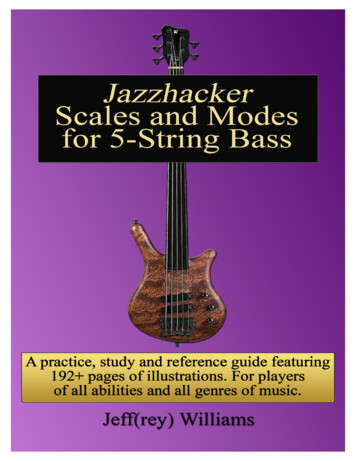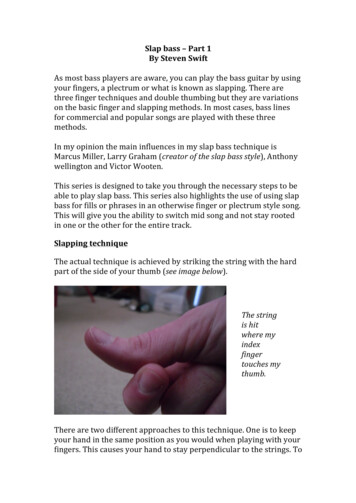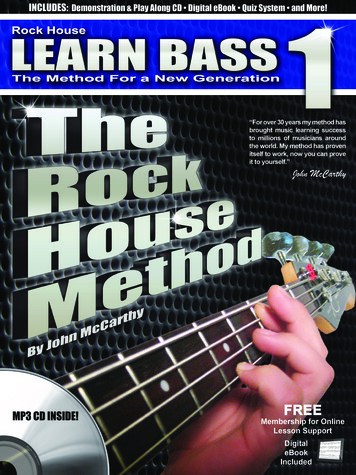
Transcription
24 pt20 ptPresentsLearn BassThe Method for a New Generation1Written & Method By:John McCarthyAdapted By: Jimmy RutkowskiSupervising Editor: Joe PalomboMusic Transcribing & Engraving: Jimmy RutkowskiProduction Manager: Joe PalomboLayout, Graphics & Design: Jimmy RutkowskiPhotography: Jimmy Rutkowski, Rodney DabneyCopy Editors: Cathy McCarthyCover Art Direction & Design:Jimmy RutkowskiHL00102681ISBN: 978-1-4768-1427-8Produced by The Rock House Method 2013 Fred Russell Publishing, LLC All Rights Reserved1
24 ptTableof Contents20 ptDigital eBook .4The Rock House MethodLearning System .5Icon Key . .5Parts of the Bass . .6Holding the Bass . .8Names of the Open Strings & Tuning . 9Finger Numbers 9Reading Tablature .10Alternating. . .11Counting Beats .11Using a Metronome .11Timing Explanations – Note Values 12Your First Bass Line .14Time Signatures .14Counting with a Drum Beat . .15Body Clock .15Rhythm – Playing with the Drums 16Bass Line #2: Gear Shifter . 16Blues Progression .17Shuffle Feel .17Blues Shuffle Progression .18Attaching Your Strap 19Finger Flexing .19Bass Line #3: Hit it Hard .20Eighth Notes .21Rhythm – Playing Eighth Notes .22Open String Bass Progression .23Riff Challenge .23The Chromatic Scale .24Notes in the First Position .255ths 26Applying 5ths: Rock Climbing . .27Single Note Riff: The Mission 27How to Read a Scale Diagram .28Minor Pentatonic Scale :First Position Key of “A” .292Minor Pentatonic Single Note Pattern .30Complete Song Progression:Clockwork .31Minor Pentatonic Scale:Positions 2 & 3 31Minor Pentatonic Single Note Pattern:Positions 2 & 3 33Blues Riff Rhythm .34Bass Power Chords .35Applying Power Chords:Double Trouble .36Triplets .36Triplet Pattern .37Staccato .39Staccato Groove .39The Major Scale: Key of “G” .40Major Triads .41Major Triad Progression: Cherry Sky .42Minor Triads .43Minor Triad Progression: Unbreakable 44Major & Minor Triads: A Spell on Me 45Octaves 46Octave Rock Progression .47Applying Octaves: The Chase .47Minor Pentatonic Scale:Positions 4 & 5 48Minor Pentatonic Triplet Pattern:Positions 4 & 5 49Finger Flexing #2 50Using a Pick .51Palm Muting .51Applying the Mute Technique:Rockit Center .52Basic Slap & Pop Technique 53Slap & Pop Exercise .54Applying the Slap & Pop Technique 54Warm Up Exercises 55Heavy Bass Progression 56Single Note Riff Rhythm .56
Appendix24pt .58Word Search .5920ptMusicalWords .60Crossword Puzzle .61Changing a String 62Bass Triads .64About the Author .71Words from the AuthorPlaying music is a rewarding art form that will last you a lifetime, I discovered that factshortly after I was given my first instrument. I have spent my career sharing the passionI have for music with others. With my teaching method, I truly believe you too will enjoyyears of fun and will pass on the passion you discover. If you follow the method step-bystep you will be successful and enjoy playing bass for years to come. When I designed TheRock House Method, my mission was to create the most complete and fun way to learn.I accomplished this by developing and systematically arranging a modern method basedon the needs and social demands of today’s players. I not only tell you where to put yourfingers, I show you ways to use what you learn so that you can make music right from thestart. I know it is hard to imagine, but even the all-time greats started somewhere, therewas a time when they too didn’t even know what a chord was. As you progress as a bassplayer, keep your mind open to all styles of music. Set-up a practice schedule that you canmanage, be consistent, challenge yourself and realize everyone learns at a different rate.Be patient, persistent and remember music is supposed to be fun!NOW, GET EXCITED, this is it. YOU are going to play bass!John McCarthy3
24 ptQuick Start Video20 ptDownload this free video from our On Demand System at RockHouseSchool.com.It will help guide you through the important first steps of getting started with yourbass.WParts of the BassA bass is made up of three main sections: the body, the neck and the headstock. All ofthe other parts of the bass are mounted on these three sections.BodyNeckHeadThe bridge is the assembly that anchors the strings to the body. Pickups are alsomounted to the body and work like little microphones that pick up the sound from thestrings. A cable is plugged into the bass’s input jack to send the signal into the amp. Mostbass guitars will also have a pickup selector switch along with volume and tone knobs. Astrap can be attached to the strap buttons to play the bass standing up.The metal bars that go across the neck are called frets. The dots between certain fretsare called position markers and help you know where your hand is on the neck whileplaying. At the end of the neck is the nut which guides the strings onto the headstock andkeeps them in place. On the headstock, the strings are wound around the tuning posts,and the tuners (also called machine heads) are used to tune the strings to pitch.6
CD Track24 ptYourFirst Bass Line20 pt7-8Get excited! It’s time to learn your first bass line. This bass line is played using alternateplucking in steady quarter notes. Follow the tablature below and be sure to use theproper finger for each note. Once you can play this without hesitation play it along with thebacking track to create a full band sound. 00 0 0 5555333333331111etc.0000 Time Signatures Time signatures are written at the beginning of a piece of music. The sole function of atime signature is to tell you how to count the music you are about to play. The top numbertells you how manythere areeach measureand the bottom number tells what beatsNumberofinbeatsper measure.type of beat is receiving the count. The typeof note receiving one beat.Number of beats per measure. Number of beatsNumberperofnotemeasure.beatsper measure.Aquarterreceivingone beat. The type of Thenotetypereceivingof noteonereceivingbeat. one beat. Indicates four beats Four beats per measure.Indicates fourIndicatesbeats four beatsFour beats perFourmeasure.beats per easure.measure.Alsoknownas “commonperper measure.Also knownAlsoas “commonknownastime.”“commontime.”per measure.Also known as “common time.”14time.”
24 ptWRests20 ptThe following examples contain your first rests. A rests is a period of silence. Likewhole, half and quarter notes you keep time only there is no sound. See what eachrest looks like below:whole notehalf notequarter noteeighth noteWhole RestHalf RestQuarter RestEighth Restrestrestrestrest4 Beats2 Beats1 Beat1/2 Beat Count: 1 2 3 4 1 2 3 4 11 & 2 & 3 & 4 &234CD TrackRhythm – Playing Eighth Notes26-27When playing eighth notes in a bass line you can create syncopated rhythms. Theserhythms contain notes played on the up beat or “&” count. In example 1 you will playnotes on the 1 – 3 – & counts along with the drum backing track.Example 3 Example30 0 1&002 & 30&0 4 & 0 40 0 0 0 Example 00000 1&2 & 3&4 &4 followed by three up beat notes played on theIn example 2 you will play onExamplethe 1 count“&” counts. This creates a very syncopated rhythm.1122&&22&&33&&44&&
CD Track24 ptMajorTriads20 pt64A triad is the three notes that make a chord. Many bass lines are written using triadpatterns. In this lesson you will learn a common major triad pattern. These are movabletriad patterns and by just playing the same pattern at other frets you will change keys.Often when playing with a guitar or keyboard player you can follow the chords they playwith the triad of the same key. This is a great way to begin creating bass lines.G MajorG MajorC Major112244C MajorG Minor1124G MinorC Minor124 4134 34434 G3Finger: 2 C25145452413322Music AssignmentGm3Finger: 1125144545241432CmTake thetriad shapes from this lesson and 5move5 themaround the neck.55You5 need to5 become familiar playing36 these anywhere 6on the3 neck.6 Remember that the3 note is the name of the triad.6 first4333411433341Dotted Quarter NotesThe dot after a note increases the duration of the note by half of its original value. Adotted quarter note would receive 1 ½ beats or counts. DottedDotted Dotted1 1/2 BeatsHalf NoteQuarter NoteQuarter Note5 55 5 55 5 55 DottedHalf Note5 55 354133
24 ptCD Track20 pt91Slap & Pop ExerciseIn this example you will slap the open E string and pop the open G string. Once you havethe bass line so you can play it smoothly play it along with the backing track. 000Count: 1S00&P2S00&P03S&P4S000&P1S00&P2S00&P03S&P4S&P CD TrackApplying the Slap & Pop Technique92-94Now let’s apply the slap & pop technique into a song. Below is a simple song that willincorporate three octave shapes. Play each separately first then put them together withthe backing track. This song is played with a swing or shuffle feel so pay close attentionto the backing track for the rhythms timing. Example 120SFinger: 53P1S175P4S120P4S53P1S175P4S1P4Example 2Finger:5420S53P1S175P4S120P4S53P1S175P4S1 P4
Parts of the Bass A bass is made up of three main sections: the body, the neck and the headstock. All of the other parts of the bass are mounted on these three sections. The bridge is the assembly that anchors the strings to the body. Pickups are also mounted to the body and work like little microphones that pick up the sound from the strings. A cable is plugged into the bass’s input jack to send the signal
